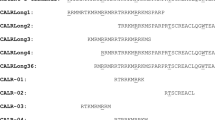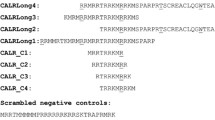Abstract
There is mounting evidence that the immune system can spontaneously clear malignant lesions before they manifest as overt cancer, albeit this activity has been difficult to demonstrate in humans. The calreticulin (CALR) exon 9 mutations are driver mutations in patients with chronic myeloproliferative neoplasms (MPN), which are chronic blood cancers. The CALR mutations generate a neo-antigen that is recognized by patient T cells, and T cells isolated from a patient with a CALR-mutation can recognize and kill autologous CALR-mutant cells. Surprisingly, healthy individuals display frequent and strong T cell responses to the CALR neo-antigens too. Furthermore, healthy individuals display immune responses to all parts of the mutant CALR epitope, and the CALR neo-epitope specific responses are memory T cell responses. These data suggest that although healthy individuals might acquire a CALR mutation, the mutant cells can be eliminated by the immune system. Additionally, a small fraction of healthy individuals harbor a CALR exon 9 mutation. Four healthy individuals carrying CALR mutations underwent a full medical examination including a bone marrow biopsy after a median follow up of 6.2 years. None of these patients displayed any signs of CALR-mutant MPN. Additionally, all healthy individuals displayed strong CALR neo-epitope specific T cell responses suggesting that these healthy individuals retained their CALR-mutant cells in the editing stage for several years. Thus, we suggest that CALR-mutant MPN could be a disease model of cancer immuno-editing, as we have demonstrated that CALR-mutant MPN displays all three stages described in the theory of cancer immuno-editing.




Similar content being viewed by others
Abbreviations
- BCR-ABL1:
-
Breakpoint cluster region-Abelson murine leukemia virus oncogene homolog
- CALR:
-
Calreticulin
- TCM :
-
Central memory T cell
- MPN:
-
Chronic myeloproliferative neoplasms
- TEM :
-
Effector memory T cell
- TEMRA :
-
Effector memory T cell expressing CD45RA
- ET:
-
Essential thrombocythemia
- JAK2:
-
Janus kinase-2
- MART-1:
-
Melanoma antigen recognized by T-cells
- MYD88:
-
Myeloid differentiation primary response 88
- NPM-1:
-
Nucleophosmine-1
- PMF:
-
Primary myelofibrosis
- PV:
-
Polycythemia vera
- TSA:
-
Tumor specific antigen
References
Stutman O (1974) Tumor development after 3-methylcholanthrene in immunologically deficient athymic-nude mice. Science 183:534–536. https://doi.org/10.1126/science.183.4124.534
Boshoff C, Weiss R (2002) Aids-related malignancies. Nat Rev Cancer 2:373–382. https://doi.org/10.1038/nrc797
Chapman JR, Webster AC, Wong G (2013) Cancer in the transplant recipient. Cold Spring Harb Perspect Med 3:a015677. https://doi.org/10.1101/cshperspect.a015677
Cervinkova M, Kucerova P, Cizkova J (2017) Spontaneous regression of malignant melanoma—is it based on the interplay between host immune system and melanoma antigens? Anticancer Drugs 28:819–830. https://doi.org/10.1097/CAD.0000000000000526
Teulings HE, Overkamp M, Ceylan E et al (2013) Decreased risk of melanoma and nonmelanoma skin cancer in patients with vitiligo: a survey among 1307 patients and their partners. Br J Dermatol 168:162–171. https://doi.org/10.1111/bjd.12111
Posthuma EF, Falkenburg JH, Apperley JF et al (1999) HLA-B8 and HLA-A3 coexpressed with HLA-B8 are associated with a reduced risk of the development of chronic myeloid leukemia. The Chronic Leukemia Working Party of the EBMT. Blood 93:3863–3865
Kuželová K, Brodská B, Fuchs O et al (2015) Altered HLA class I profile associated with type A/D nucleophosmin mutation points to possible anti-nucleophosmin immune response in acute myeloid leukemia. PLoS ONE 10:1–12. https://doi.org/10.1371/journal.pone.0127637
Burnet M (1970) The concept of immunological surveillance. Prog Exp Tumor Res 13:1–27
Dunn GP, Old LJ, Schreiber RD (2004) The three es of cancer immunoediting. Annu Rev Immunol 22:329–360. https://doi.org/10.1146/annurev.immunol.22.012703.104803
Dunn GP, Bruce AT, Ikeda H et al (2002) Cancer immunoediting : from immuno- surveillance to tumor escape. Nat Immunol 3:991–998. https://doi.org/10.1038/ni1102-991
Blankenstein T, Coulie PG, Gilboa E, Jaffee EM (2012) The determinants of tumour immunogenicity. Nat Rev Cancer 12:307–313. https://doi.org/10.1038/nrc3246
Coulie PG, Van den Eynde BJ, van der Bruggen P, Boon T (2014) Tumour antigens recognized by T lymphocytes: at the core of cancer immunotherapy. Nat Rev Cancer 14:135–146. https://doi.org/10.1038/nrc3670
Prior IA, Lewis PD, Mattos C (2012) A comprehensive survey of ras mutations in cancer. Cancer Res 72:2457–2467. https://doi.org/10.1158/0008-5472.CAN-11-2612
Qin H, Chen W, Takahasi M et al (1995) CD4+ T-cell immunity to mutated ras protein in pancreatic and colon cancer patients. Cancer Res 55:2984–2987
Jung S, Schluesener HJ (1991) Human T lymphocytes recognize a peptide of single point-mutated, oncogenic ras proteins. J Exp Med 173:273–276. https://doi.org/10.1084/jem.173.1.273
Gedde-Dahl T, Eriksen JA, Thorsby E, Gaudernack G (1992) T-cell responses against products of oncogenes: generation and characterization of human T-cell clones specific for p21 ras-derived synthetic peptides. Hum Immunol 33:266–274. https://doi.org/10.1016/0198-8859(92)90334-J
Wedén S, Klemp M, Gladhaug IP et al (2011) Long-term follow-up of patients with resected pancreatic cancer following vaccination against mutant K-ras. Int J Cancer 128:1120–1128. https://doi.org/10.1002/ijc.25449
Shono Y, Tanimura H, Iwahashi M et al (2003) Specific T-cell immunity against Ki-ras peptides in patients with pancreatic and colorectal cancers. Br J Cancer 88:530–536. https://doi.org/10.1038/sj.bjc.6600697
Kubuschok B, Neumann F, Breit R et al (2006) Naturally occurring T-cell response against mutated p21 Ras oncoprotein in pancreatic cancer. Clin Cancer Res 12:1365–1372. https://doi.org/10.1158/1078-0432.CCR-05-1672
Takahashi M, Chen W, Byrd DR et al (1995) Antibody to ras proteins in patients with colon cancer. Clin Cancer Res 1:1071–1077
Somasundaram R, Swoboda R, Caputo L et al (2006) Human leukocyte antigen-A2-restricted CTL responses to mutated BRAF peptides in melanoma patients. Cancer Res 66:3287–3293. https://doi.org/10.1158/0008-5472.CAN-05-1932
Butt NM, Rojas JM, Wang L et al (2005) Circulating bcr-abl-specific CD8+ T cells in chronic myeloid leukemia patients and healthy subjects. Haematologica 90:1315–1323
Rusakiewicz S, Madrigal A, Travers P, Dodi AI (2009) BCR/ABL-specific CD8+ T cells can be detected from CML patients, but are only expanded from healthy donors. Cancer Immunol Immunother 58:1449–1457. https://doi.org/10.1007/s00262-009-0703-x
Treon SP, Xu L, Yang G et al (2012) MYD88 L265P somatic mutation in Waldenström’s macroglobulinemia. N Engl J Med 367:826–833. https://doi.org/10.1056/NEJMoa1200710
Nelde A, Walz JS, Kowalewski DJ et al (2017) HLA class I-restricted MYD88 L265P-derived peptides as specific targets for lymphoma immunotherapy. Oncoimmunology 6:1–11. https://doi.org/10.1080/2162402X.2016.1219825
Nielsen JS, Chang AR, Wick DA et al (2017) Mapping the human T cell repertoire to recurrent driver mutations in MYD88 and EZH2 in lymphoma. Oncoimmunology 6:e1321184. https://doi.org/10.1080/2162402X.2017.1321184
Falini B, Mecucci C, Tiacci E et al (2005) Cytoplasmic nucleophosmin in acute myelogenous leukemia with a normal karyotype. N Engl J Med 352:254–266. https://doi.org/10.1056/NEJMoa041974
Greiner J, Schneider V, Schmitt M et al (2013) Immune responses against the mutated region of cytoplasmatic NPM1 might contribute to the favorable clinical outcome of AML patients with NPM1 mutations (NPM1mut). Blood 122:1087–1088
Pittet MJ, Valmori D, Dunbar PR et al (1999) High frequencies of naive Melan-A/MART-1-specific CD8(+) T cells in a large proportion of human histocompatibility leukocyte antigen (HLA)-A2 individuals. J Exp Med 190:705–715. https://doi.org/10.1084/jem.190.5.705
Spivak JL (2017) Myeloproliferative neoplasms. N Engl J Med 376:2168–2181. https://doi.org/10.1056/NEJMra1406186
Levine RL, Gilliland DG (2008) Myeloproliferative disorders. Blood 112:2190–2198. https://doi.org/10.1182/blood-2008-03-077966
Levine RL, Wadleigh M, Cools J et al (2005) Activating mutation in the tyrosine kinase JAK2 in polycythemia vera, essential thrombocythemia, and myeloid metaplasia with myelofibrosis. Cancer Cell 7:387–397. https://doi.org/10.1016/j.ccr.2005.03.023
Kralovics R, Passamonti F, Buser AAS et al (2005) A gain-of-function mutation of JAK2 in myeloproliferative disorders. N Engl J Med 352:1779–1790. https://doi.org/10.1056/NEJMoa051113
Nangalia J, Massie CE, Baxter EJ et al (2013) Somatic CALR mutations in myeloproliferative neoplasms with nonmutated JAK2. N Engl J Med 369:2391–2405. https://doi.org/10.1056/NEJMoa1312542
Klampfl T, Gisslinger H, Harutyunyan AS et al (2013) Somatic mutations of calreticulin in myeloproliferative neoplasms. N Engl J Med 369:2379–2390. https://doi.org/10.1056/NEJMoa1311347
Holmström MO, Riley CH, Svane IM et al (2016) The CALR exon 9 mutations are shared neoantigens in patients with CALR mutant chronic myeloproliferative neoplasms. Leukemia 30:2413–2416. https://doi.org/10.1038/leu.2016.233
Holmström MO, Martinenaite E, Ahmad SM et al (2018) The calreticulin (CALR) exon 9 mutations are promising targets for cancer immune therapy. Leukemia 32:429–437. https://doi.org/10.1038/leu.2017.214
Holmström MO, Ahmad SM, Klausen U et al (2019) High frequencies of circulating memory T cells specific for calreticulin exon 9 mutations in healthy individuals. Blood Cancer J 9:8. https://doi.org/10.1038/s41408-018-0166-4
Wang JC, Chen C, Kundra A et al (2019) Programmed cell death receptor (PD-1) ligand (PD-L1) expression in Philadelphia chromosome-negative myeloproliferative neoplasms. Leuk Res 79:52–59. https://doi.org/10.1016/j.leukres.2019.02.010
Keilholz U, Weber J, Finke JH et al (2002) Immunologic monitoring of cancer vaccine therapy: results of a workshop sponsored by the Society for Biological Therapy. J Immunother 25:97–138
Cordua S, Kjaer L, Skov V et al (2019) Prevalence and phenotypes of JAK2 V617F and Calreticulin mutations in a Danish general population. Blood 134:469–479. https://doi.org/10.1182/blood.2019001113
Hsieh C-L, Chen D-S, Hwang L-H (2002) Tumor-induced immunosuppression: a barrier to immunotherapy of large tumors by cytokine-secreting tumor vaccine. Hum Gene Ther 11:681–692. https://doi.org/10.1089/10430340050015581
Holmström MO, Novotny GW, Petersen J et al (2019) Progression of JAK2- mutant polycythemia vera to CALR -mutant myelofibrosis severely impacts on disease phenotype and response to therapy. Leuk Lymphoma 1:1–4. https://doi.org/10.1080/10428194.2019.1633634
Massari F, Santoni M, Ciccarese C et al (2015) PD-1 blockade therapy in renal cell carcinoma: current studies and future promises. Cancer Treat Rev 41:114–121. https://doi.org/10.1016/J.CTRV.2014.12.013
Holmström MO, Hasselbalch HC (2019) Cancer immune therapy for myeloid malignancies: present and future. Semin Immunopathol 41:97–109. https://doi.org/10.1007/s00281-018-0693-x
Moodie Z, Price L, Gouttefangeas C et al (2010) Response definition criteria for ELISPOT assays revisited. Cancer Immunol Immunother 59:1489–1501. https://doi.org/10.1007/s00262-010-0875-4
Acknowledgements
We thank Merete Jonassen, laboratory technician, for excellent technical assistance and for teaching Morten Orebo Holmström to perform experiments.
Funding
The writing of this paper and the experiments described herein were partially funded by the Danish Cancer Society (Kræftens Bekæmpelse), Grant numbers R149-A10159-B120 and R90-A6143-14-S2, awarded to Hans Carl Hasselbalch.
Author information
Authors and Affiliations
Contributions
MOH: designed the studies, performed the experiments, and wrote the manuscript. SC: designed the studies. VS: designed the studies and performed experiments. LK: designed the studies and performed experiments. NP: designed the studies and performed experiments. CE: designed the studies and performed experiments. HCH: designed the studies and wrote the manuscript. MHA: designed the studies and wrote the manuscript.
Corresponding author
Ethics declarations
Conflict of interest
Morten Orebo Holmström, Mads Hald Andersen, and Hans Carl Hasselbalch have filed a patent regarding CALR exon 9 mutations as targets for cancer immune therapy. The patent has been transferred to Zealand University Hospital, Zealand Region and to Herlev Hospital, Capital Region, Denmark, according to Danish Law concerning inventions created at public research institutions. The authors declare that there are no other conflicts of interest.
Ethical standards
All projects described herein were approved by the local Ethics Committee in Zealand Region, Denmark, with the approval numbers: SJ-456, SJ-585, SJ-114, SJ-113, and SJ-452.
Informed consent
All patients and healthy donors provided both written and oral informed consent on the use of their biological material for research and for publication. The consent was received before the sampling of biological material from the individual.
Additional information
Publisher's Note
Springer Nature remains neutral with regard to jurisdictional claims in published maps and institutional affiliations.
Rights and permissions
About this article
Cite this article
Holmström, M.O., Cordua, S., Skov, V. et al. Evidence of immune elimination, immuno-editing and immune escape in patients with hematological cancer. Cancer Immunol Immunother 69, 315–324 (2020). https://doi.org/10.1007/s00262-019-02473-y
Received:
Accepted:
Published:
Issue Date:
DOI: https://doi.org/10.1007/s00262-019-02473-y




